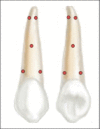Effects of low-intensity laser therapy on the rate of orthodontic tooth movement: A clinical trial
- PMID: 25225562
- PMCID: PMC4163827
Effects of low-intensity laser therapy on the rate of orthodontic tooth movement: A clinical trial
Abstract
Background: Low-intensity laser therapy (LILT) can be utilized for different treatments in the field of orthodontics and dentofacial orthopedics. The aim of the present study was to evaluate the efficacy of LILT on (1) the rate of canine movement during canine retraction phase and (2) evaluate the radiographic changes occurring during LILT around the irradiated area.
Materials and methods: A total of 10 patients of both genders were included for this study. One quadrant of the upper arch was considered control group (CG) and received mechanical activation of the canine teeth with 150 g. The opposite quadrant received the same mechanical activation and was also irradiated with a diode emitting light (gallium-arsenide laser) at 904 nm, for 10 s at 12 mW, at 4.2 J/cm(2). Laser application was done on 1(st) day, 3(rd), 7(th), 14(th), 21(th), 28(th), 35(th), 42(nd), 49(th), 56(th) day respectively during the canine retraction phase. Distance was measured on 1(st) day, 35(th) day and 63(rd) day and appliance activation was done on 1(st) and 35(th) day. Results were analyzed using t-test with the significance level set at P < 0.01.
Results: Mean value obtained from 1(st) to 63(rd) day was 3.30 ± 2.36 mm for CG and 3.53 ± 2.30 mm for laser group (LG).
Conclusion: There was no statistically significant difference in the rate of tooth movement during canine retraction between the LG and the CG. There was no evidence of any pathologic changes in the radiograph following LILT.
Keywords: Bone remodeling; canine retraction; gallium-arsenide diode laser; orthodontic tooth movement.
Conflict of interest statement
Figures







References
-
- Cruz DR, Kohara EK, Ribeiro MS, Wetter NU. Effects of low-intensity laser therapy on the orthodontic movement velocity of human teeth: A preliminary study. Lasers Surg Med. 2004;35:117–20. - PubMed
-
- Limpanichkul W, Godfrey K, Srisuk N, Rattanayatikul C. Effects of low-level laser therapy on the rate of orthodontic tooth movement. Orthod Craniofac Res. 2006;9:38–43. - PubMed
-
- Yamasaki K, Miura F, Suda T. Prostaglandin as a mediator of bone resorption induced by experimental tooth movement in rats. J Dent Res. 1980;59:1635–42. - PubMed
-
- Yamasaki K, Shibata Y, Imai S, Tani Y, Shibasaki Y, Fukuhara T. Clinical application of prostaglandin E1 (PGE1) upon orthodontic tooth movement. Am J Orthod. 1984;85:508–18. - PubMed
-
- Valiathan A, Dhar S. Prostaglandins and enhanced orthodontic tooth movement: In search of the silver bullet. Curr Sci. 2006;90:311–3.
LinkOut - more resources
Full Text Sources
Miscellaneous
